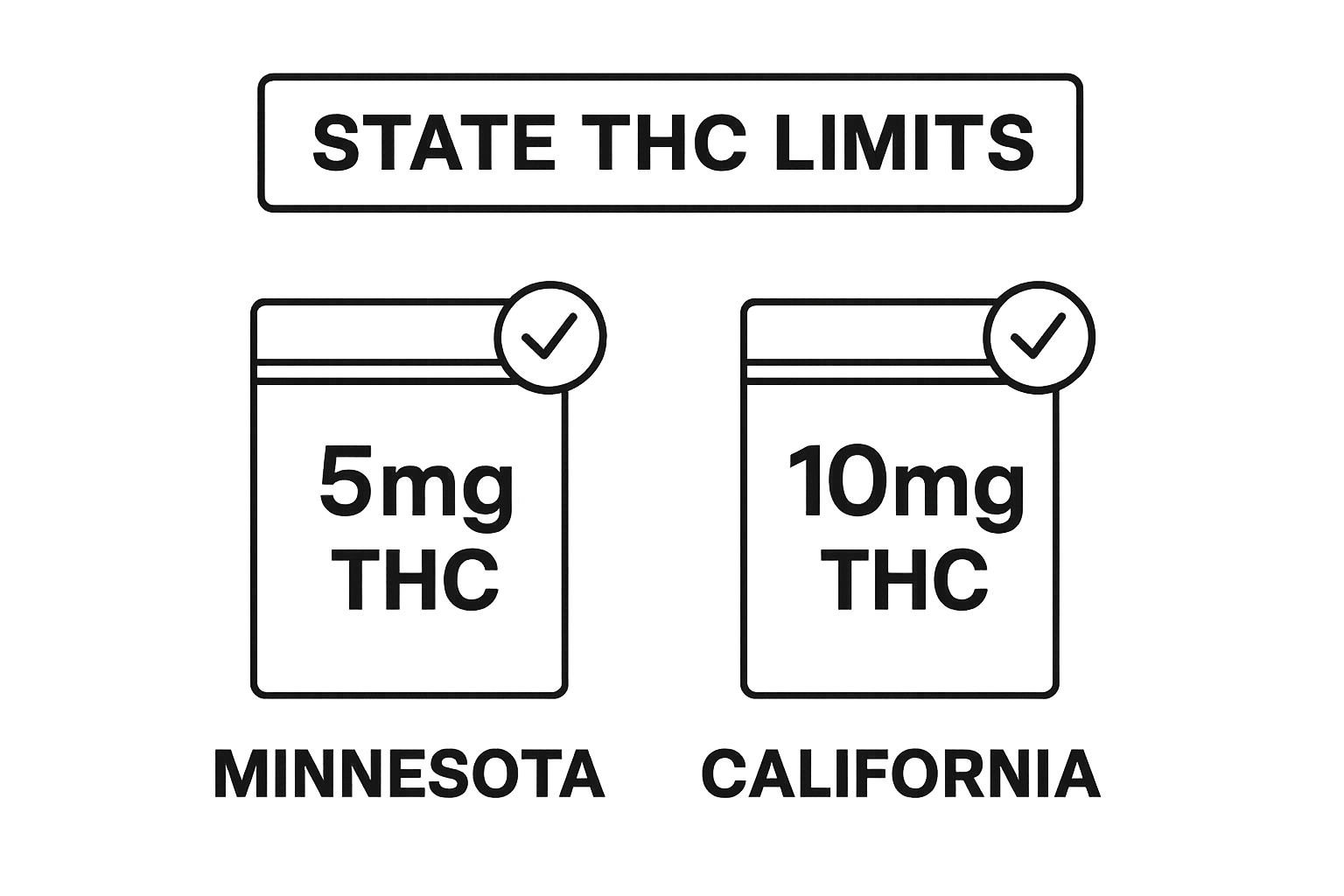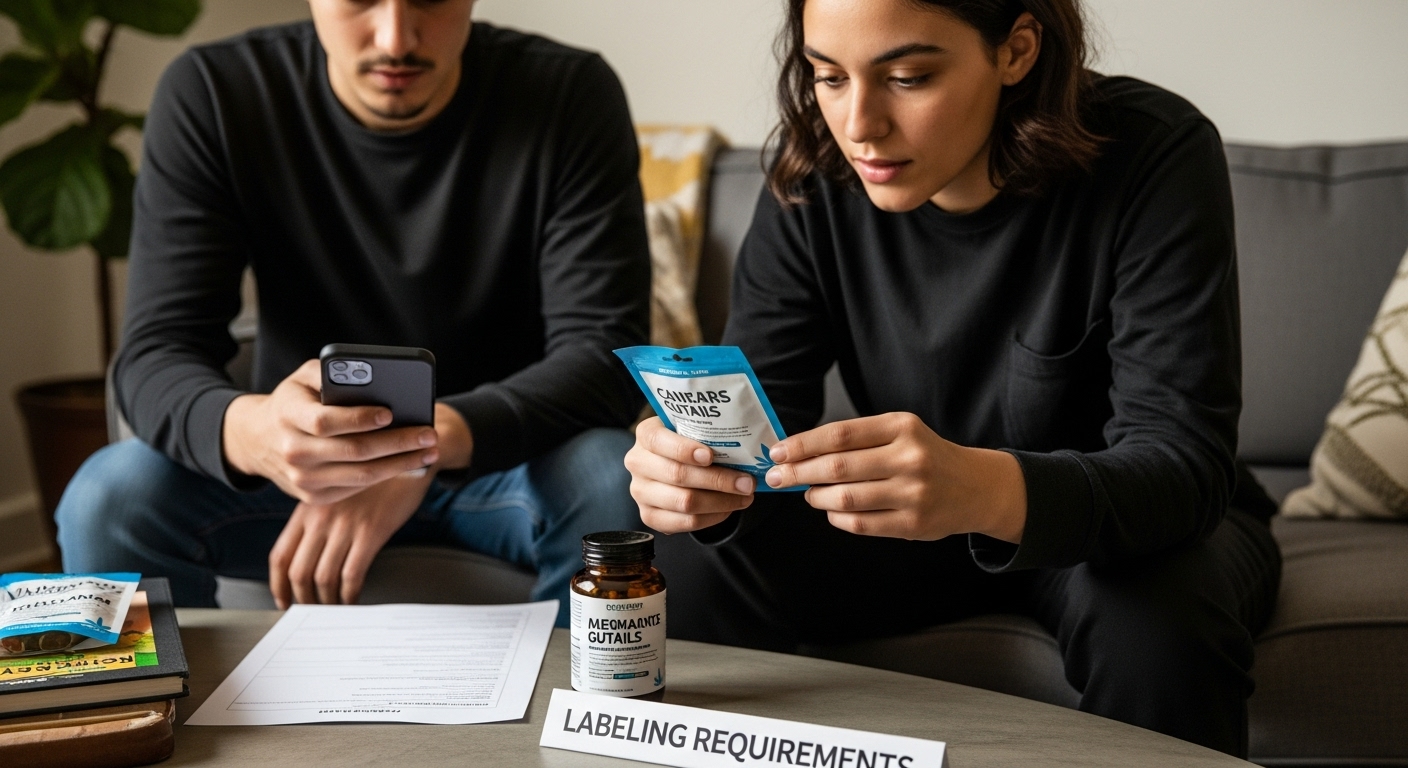Blog
Understanding Cannabis Gummy Compliance for Consumers
Cannabis gummies have fast become the go-to edible for people who want a discreet and easy way to try cannabis. Here is something that may surprise you. Some states allow only 5 mg of THC per serving and 50 mg per package, and require child-resistant packaging by law. Even with these strict controls, the rules for making and selling these treats can change wildly from one state to the next. That means a gummy you buy in one place could be totally illegal or unsafe just a few miles away.
Table of Contents
- What Are Cannabis Gummies And Their Compliance Standards?
- Why Cannabis Gummy Compliance Is Important For Safety
- How Cannabis Gummy Regulations Vary By State
- Key Components Of Cannabis Gummy Labeling Requirements
- Real-World Implications Of Cannabis Gummy Compliance For Users
Quick Summary
| Takeaway | Explanation |
|---|---|
| Cannabis gummies require strict compliance standards | Regulations ensure safety, potency, and labeling to protect consumers from risks. |
| Key labeling elements are mandatory for transparency | Information like cannabinoid content and dosage must be clear to inform consumers of effects. |
| Variability in state regulations can complicate compliance | Differences in THC limits and testing protocols impact how products are developed and marketed. |
| Child-resistant packaging is essential for safety | Effective packaging helps prevent accidental ingestion, especially among children and inexperienced users. |
| Non-compliance poses serious health risks | Users may face inconsistent effects or contamination, underscoring the importance of following regulations. |
What are Cannabis Gummies and Their Compliance Standards?
Cannabis gummies represent a popular edible form of cannabis consumption, offering consumers a discreet and convenient method of experiencing cannabinoid effects. These soft, chewable products combine cannabis extracts with traditional gummy candy ingredients, creating a palatable alternative to smoking or vaping.
Understanding Cannabis Gummy Composition
Cannabis gummies are manufactured using carefully controlled processes that integrate cannabinoid extracts into a gelatin or pectin base. The composition typically includes key components:
- Active cannabinoid extracts (THC or CBD)
- Natural fruit flavors
- Sweeteners
- Binding agents
- Precise dosage measurements
Manufacturers must adhere to strict regulatory standards that govern the production, potency, and labeling of these edible products. According to California Department of Cannabis Control, these standards include preventing product designs that might appeal to children and requiring clear, informative labeling.
Compliance and Safety Regulations
Comprehensive cannabis gummy compliance involves multiple regulatory dimensions. State-level regulations mandate specific requirements for product safety, potency, and consumer protection. Key compliance standards include:
- Maximum THC concentration limits
- Mandatory third-party laboratory testing
- Clear dosage information
- Child-resistant packaging
- Precise cannabinoid content verification
For instance, Minnesota Office of Cannabis Management specifies that hemp-derived cannabinoid products must contain no more than 0.3% THC, with strict serving size limitations of 5 mg THC per serving and 50 mg per package.
Understanding these compliance standards ensures consumers can make informed decisions about cannabis gummy consumption, prioritizing safety, legal adherence, and predictable experiences.
Why Cannabis Gummy Compliance is Important for Safety
Cannabis gummy compliance represents a critical public health safeguard, ensuring consumer protection through rigorous regulatory standards that mitigate potential risks associated with cannabis edible consumption. These comprehensive safety protocols address multiple dimensions of product manufacturing, distribution, and consumption.
Consumer Health Protection Mechanisms
Safety compliance for cannabis gummies focuses on preventing unintended health consequences through meticulous quality control and standardized manufacturing processes. Key protection strategies include:
- Precise cannabinoid concentration verification
- Prevention of harmful contaminant exposure
- Standardized dosage measurements
- Clear product labeling
- Child-resistant packaging design
Accidental ingestion and overconsumption pose significant risks, particularly for vulnerable populations like children and inexperienced consumers. According to the Centers for Disease Control and Prevention, strict compliance measures are essential in reducing potential emergency medical incidents related to cannabis edible consumption.
Regulatory Framework and Risk Mitigation
Comprehensive compliance standards serve multiple critical functions beyond immediate consumer safety. These regulations create a structured environment that:
- Establishes transparent manufacturing guidelines
- Ensures product consistency
The regulatory framework mandates extensive testing protocols that verify product purity, potency, and safety. Compliance requirements include comprehensive laboratory assessments that screen for potential contaminants such as pesticides, heavy metals, and microbial agents.
By implementing stringent compliance standards, regulatory bodies can effectively minimize health risks while providing consumers with reliable, predictable cannabis gummy experiences. These measures protect public health and establish consumer trust in the rapidly evolving cannabis product marketplace.
The table below compares key regulatory elements for cannabis gummies, helping you visualize how compliance standards safeguard product safety and consumer well-being.
| Regulatory Element | Purpose | Example/Details |
|---|---|---|
| THC Concentration Limits | Controls psychoactive potency | 5 mg THC per serving; 50 mg per package (some states) |
| Lab Testing Requirement | Ensures purity, safety, and potency | Third-party laboratory verification |
| Child-Resistant Packaging | Prevents accidental ingestion | Packaging difficult for children to open |
| Clear Dosage Information | Helps prevent overconsumption | Dosage and cannabinoid content displayed on label |
| Labeling Standards | Promotes transparency and informed choices | Total cannabinoids, health warnings, manufacturer info |
| Prohibited Marketing to Children | Reduces youth appeal and risk | No cartoons or child-attracting designs |
How Cannabis Gummy Regulations Vary by State
Cannabis gummy regulations demonstrate significant diversity across different states, reflecting complex legal landscapes and varied approaches to cannabis product management. This regulatory complexity creates a challenging environment for manufacturers, retailers, and consumers navigating cannabis edible markets.
Regional Regulatory Differences
Each state establishes unique frameworks governing cannabis gummy production, distribution, and consumption. Key regulatory variations include:
- Permissible THC concentration limits
- Packaging and labeling requirements
- Age restrictions for purchase
- Sales channel regulations
- Laboratory testing protocols
According to the National Safety Council, these regulatory disparities create substantial challenges for cannabis businesses operating across multiple jurisdictions, requiring meticulous compliance strategies.
Compliance Complexity in Different Legal Environments
States categorize cannabis regulations across several distinctive models:
- Fully recreational cannabis states
- Medical cannabis states
- States with limited medical cannabis programs
- States with hemp-derived cannabinoid allowances
- States maintaining complete prohibition
These categorizations significantly impact cannabis gummy manufacturing standards, with each legal framework imposing distinct requirements for product development, testing, and distribution. Manufacturers must carefully navigate these intricate regulatory landscapes, adapting their production processes to meet specific state-level mandates.

Understanding these nuanced regulatory differences is crucial for consumers and industry professionals, ensuring compliance, safety, and legal adherence in the dynamic cannabis marketplace.
Key Components of Cannabis Gummy Labeling Requirements
Cannabis gummy labeling represents a critical mechanism for ensuring consumer safety, providing transparent information about product composition, potency, and potential health considerations. These comprehensive labeling requirements serve as a crucial communication tool between manufacturers and consumers.
Essential Informational Elements
Labeling requirements for cannabis gummies encompass a wide range of mandatory information designed to promote consumer understanding and safety. Critical label components include:
- Total cannabinoid content (THC and CBD)
- Serving size and total servings per package
- Manufacturer information and license number
- Production and expiration dates
- Specific health and safety warnings
According to the California Department of Cannabis Control, these labeling standards aim to prevent misuse, protect vulnerable populations, and provide clear, comprehensive product information.
Regulatory Compliance and Consumer Protection
Labeling requirements extend beyond simple product information, incorporating stringent design and presentation guidelines:
- Child-resistant packaging specifications
- Prohibition of marketing designs appealing to children
- Clear, legible font requirements
- Mandatory universal cannabis symbol
- Explicit dosage and consumption guidance
These comprehensive labeling standards create a robust framework that balances consumer education, product transparency, and public safety. By mandating detailed, standardized information, regulatory bodies ensure that cannabis gummy consumers can make informed decisions about product consumption, potential effects, and responsible usage.
This table summarizes the required labeling components for compliant cannabis gummy products, making it easy to check whether a product’s packaging meets regulatory expectations.
| Labeling Component | Description |
|---|---|
| Total Cannabinoid Content | Amount of THC and/or CBD per serving/package |
| Serving Size and Servings per Pack | Dosage per gummy and total number of servings |
| Manufacturer and License Number | Company name and required state license identifier |
| Production and Expiration Dates | Date made and best-by date for freshness/safety |
| Health and Safety Warnings | Cautions about use, risks, and legal age restrictions |
| Universal Cannabis Symbol | Icon indicating product contains cannabis ingredients |
| Clear Dosage Guidance | Explicit instructions for safe consumption |

Real-World Implications of Cannabis Gummy Compliance for Users
Cannabis gummy compliance directly impacts consumer safety, health outcomes, and overall product experience. The real-world consequences of rigorous regulatory standards extend far beyond theoretical guidelines, affecting individual user interactions with cannabis edibles.
Consumer Health and Safety Risks
Non-compliant cannabis gummies can expose consumers to significant health and safety risks. Potential complications include:
- Inconsistent THC concentration
- Potential contamination with harmful substances
- Increased risk of accidental overconsumption
- Unpredictable psychoactive effects
- Potential exposure to undeclared ingredients
According to the Federal Trade Commission, inadequate compliance can lead to serious health incidents, particularly concerning accidental ingestion by children.
Product Reliability and Consumer Trust
Compliance directly influences product reliability and consumer confidence in the cannabis marketplace. Key reliability factors encompass:
- Accurate labeling of cannabinoid content
- Consistent product quality
- Transparent manufacturing processes
- Standardized dosage measurements
- Comprehensive safety testing
Users rely on strict compliance measures to make informed decisions about cannabis consumption, understanding potential effects, and managing personal health considerations. By enforcing robust regulatory standards, the cannabis industry can build consumer trust and promote responsible product usage.
Trust the Power of Real Cannabis Gummy Compliance with Good Tide
Are you tired of worrying about mislabeling, unpredictable effects, or hidden ingredients when shopping for cannabis gummies? In the world of cannabis edibles, safety, compliance, and transparency are critical for your peace of mind. The article “Understanding Cannabis Gummy Compliance for Consumers” highlights the risks of inaccurate labeling, contamination, and accidental overconsumption. At Good Tide CBD Gummies, these pain points are top priorities, and we provide real solutions you can count on.

Feel confident about every purchase. Every gummy at Good Tide comes with detailed information about ingredients, effects, and third-party lab results, so you always know what you are getting. Enjoy premium, natural extraction methods and vibrant tropical flavors, all made for verified purity and consistent quality. Shop with us now to enjoy safe, compliant cannabis-infused gummies that deliver reliable results every time. Discover our full range at Good Tide CBD Gummies and experience the security of knowing your edibles meet the highest standards.
Frequently Asked Questions
What are cannabis gummies?
Cannabis gummies are edible products infused with cannabis extracts, typically containing active cannabinoids like THC or CBD, combined with sweeteners and fruit flavors to create a chewy candy alternative to smoking or vaping.
How do I know the potency of cannabis gummies?
The potency of cannabis gummies is indicated on the packaging through clear labeling, which includes the total cannabinoid content per serving and the total number of servings per package. Compliance standards ensure this information is accurately presented.
What safety standards do cannabis gummies comply with?
Cannabis gummies must adhere to strict safety regulations, which include maximum THC concentration limits, mandatory third-party laboratory testing, clear dosage information, child-resistant packaging, and verification of cannabinoid content to ensure consumer protection and safety.
Why is compliance important for cannabis gummies?
Compliance is crucial for cannabis gummies as it ensures consistent product quality, accurate labeling, and consumer safety. It helps mitigate risks like accidental overconsumption and exposure to harmful substances, ultimately protecting public health.
Recommended
- Understanding Why Choose Hash Rosin for Cannabis Consumption – GOOD TIDE CBD GUMMIES
- What is Rosin Pressing? Understanding Solventless Cannabis Extracts – GOOD TIDE CBD GUMMIES
- 7 Types of Cannabis Extracts You Should Know About – GOOD TIDE CBD GUMMIES
- 7 Types of Cannabis Extraction You Need to Know – GOOD TIDE CBD GUMMIES

